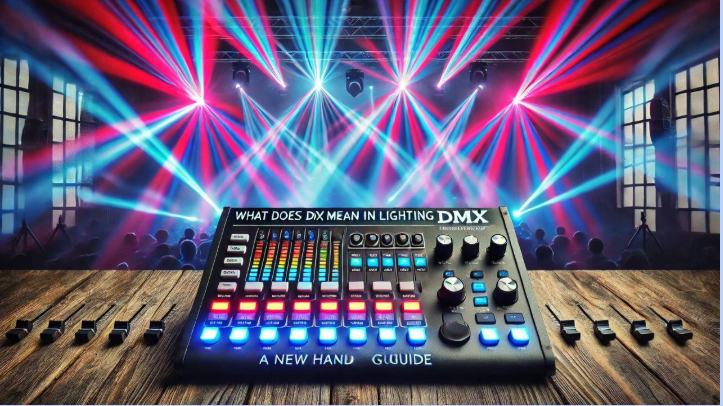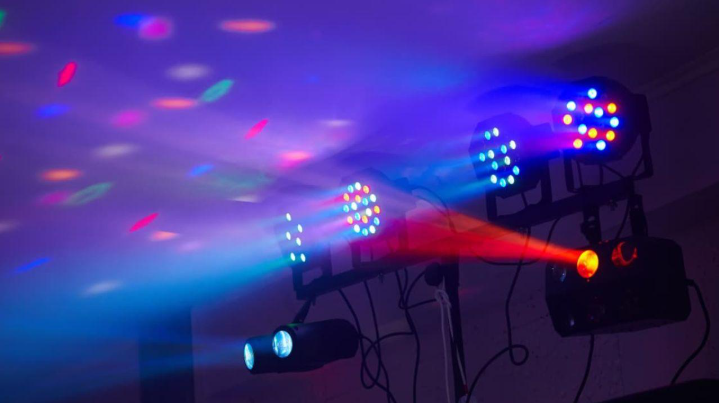GENERAL
DMX and LED Lighting: Understanding Digital Multiplex Control and Its Impact

The DMX system represents one of the most advanced lighting control technologies, and it has become the primary standard for contemporary applications. DMX represents a common term found in LED lighting discussions yet remains unclear to people who lack understanding of its technology definition and operational principles. An led tape light dmx system allows precise control over brightness, color, and effects, making it ideal for dynamic lighting displays. The standardized protocol DMX stands for Digital Multiplex, which controls lighting effects across stage productions, architectural lighting applications, commercial displays, and home automation systems. DMX operates as a crucial modern lighting system component because it allows users to control numerous fixtures simultaneously with both precision and flexible control.

The Origin and Development of DMX
In 1986, USITT established the DMX512 protocol to solve problems that plagued earlier lighting control systems. The adoption of DMX introduced a new era in lighting control systems because analog signals previously used extensive wiring and produced unreliable results. The installation of lighting fixtures became complicated because each fixture required its own specific control line.
DMX introduced a digital communication system enabling controllers to control multiple fixtures through one unified data cable. Standardization of lighting systems through DMX led to simplified setup processes and enhanced reliability along with extended programming potential. The development of DMX technology has extended its original theater-based usage to become an essential control system for numerous industries that need precise lighting management.
How DMX Works in LED Lighting
The digital protocol DMX functions as a communication system that directs controllers to send signals that control lighting fixtures for intensity levels, color selection, and movement patterns. The standard setup for DMX includes a controller unit and DMX-enabled fixtures, which are linked through data cables to exchange instructions. The protocol manages communication through a step-by-step packet system that controls the various functions of connected fixtures.
The standard DMX system works through 512 channels, which enables the control of 512 separate parameters across each universe. Each lighting device receives data from its assigned address within the universe and understands its intended instructions but ignores data meant for other fixtures. The structured design allows designers to build intricate lighting setups because every fixture executes commands exactly as programmed.
LED lighting benefits from DMX control through its ability to provide users with extraordinary control over brightness settings, color temperature adjustments, and dynamic effects operation. The RGB and RGBW LED strips obtain their wide color range, and fluid lighting transitions through DMX signal control. DMX proves most suitable for applications needing automated and coordinated lighting displays because it allows users to synchronize various lights and effects.
Benefits of LED Lighting Systems
The main benefit of using DMX control for LED lighting systems is its ability to deliver exact and customizable control over numerous fixtures. With DMX, users can easily program their lighting sequences and automate transitions between effects because this system eliminates the need for manual adjustments. Stage productions greatly benefit from this advanced control function since it ensures perfect synchronization between lighting effects, musical performances, and stage effects.
DMX implements dimming and scheduling features that improve energy efficiency. The DMX compatibility of LED fixtures enables programmers to set intensity levels that manage power usage while preserving appropriate lighting conditions. The architectural lighting industry uses this capability to program building and monument illumination following specific patterns and event schedules.
DMX provides scalable operations, which is a significant advantage. The DMX protocol enables users to control either small LED fixture collections or extensive venue-wide lighting networks through a system that provides easy integration and growth capabilities. The DMX protocol enables control of numerous lighting parameters through multiple universes, which makes it suitable for large productions, concert events, and commercial installations.

DMX Applications Beyond Entertainment
The entertainment industry created DMX, but today, it serves purposes that exceed live performance illumination. Building facades, bridges, and landmarks get dynamic color-changing effects through architectural lighting designers who employ DMX technology. The implementation of DMX-controlled LED fixtures in urban environments enables cities to generate spectacular nighttime scenes, which simultaneously improve their public areas and attract tourists.
Retail businesses utilize DMX-controlled lighting because adjustable schemes through DMX enable behavior modification among customers while making their displays more noticeable. DMX controls allow stores to set ambiance lighting and create highlight effects that both improve customer shopping experiences and spotlight particular merchandise. DMX controls the lighting systems of restaurants and hotels alongside event venues to help them build distinctive settings that match their brand personality.
Modern residential smart home automation systems now use DMX-compatible LED lights to enable homeowners to customize their lighting environments. The sophistication of residential lighting has increased through DMX technology, which enables users to modify living space illumination and match outdoor lights with music or seasonal elements.
Understanding DMX Addressing and Configuration
Novice users of DMX need to learn how to properly address and configure their lighting fixtures on a DMX network. Every DMX-compatible light needs a starting address to specify the data stream section it will process. The proper planning of addressing becomes essential because fixture types need multiple channels to handle brightness, color, and movement controls while ensuring no address conflicts occur.
Real-time updates of all connected fixtures occur through the continuous data stream from a DMX controller system. Programmers who work with DMX-controlled LED lighting systems benefit from interfaces between software controllers and hardware consoles that enable user modifications and preset storage along with automated sequence control. Applications that need dynamic lighting effects, such as stage shows and multimedia installations, depend heavily on this flexible system.
Conclusion
The Digital Multiplex system (DMX) transformed LED lighting control through its ability to deliver precise control and flexible operation in multiple industries. DMX started its life in theater staging before spreading across architectural spaces and commercial buildings and finally reaching residential areas. The tool provides essential capabilities to manage various fixtures alongside dynamic effect generation and smart lighting integration for designers and lighting professionals. DMX technology will advance alongside technological progress through the implementation of wireless capabilities, IoT integration, and novel lighting effects. DMX-controlled LED lighting stands as a versatile tool for creating mesmerizing visual effects since it can light up stages at concerts or improve building exteriors and retail environments.
GENERAL
8 In-Demand Coding Languages You Can Learn in 2025

The digital realm is in constant evolution, and staying ahead requires mastering the right tools. In 2025, coding proficiency will be more crucial than ever, with certain languages dominating the tech landscape. To navigate this dynamic environment, understanding which languages are in high demand is essential. This blog will delve into eight pivotal coding languages projected to be highly sought after in 2025, exploring their applications, career prospects, and why they deserve your attention.
The digital transformation across industries has fueled a surge in demand for professionals proficient in in-demand coding languages. As businesses increasingly rely on software and data-driven solutions, the need for skilled developers in languages like Python, JavaScript, and Java is paramount. This demand extends to specialized areas like AI and cybersecurity, where expertise in languages like R and Go is crucial.
Coding programming bootcamp offers an accelerated path to acquire these vital skills. These intensive programs focus on practical application, providing hands-on experience through projects and real-world scenarios. By compressing years of learning into months, bootcamps equip individuals with the necessary proficiency to enter the tech industry quickly, bridging the skill gap and meeting the growing demand for qualified coding professionals.
What is coding?
Coding is the process of writing instructions for computers to execute specific tasks. It involves using programming languages, like Python or JavaScript, to create software, websites, and applications. Coders translate human-readable instructions into machine-understandable code, enabling computers to perform diverse functions. It’s a fundamental skill in the digital age, driving innovation and shaping technology. Coding combines logic, problem-solving, and creativity to build digital solutions.
Top 8 In-demand Coding Languages to Learn in 2025
Python: Renowned for its clear syntax and extensive libraries, Python excels in web development, data science, AI, and automation. Its versatility and readability make it a favorite for both beginners and experienced developers, driving innovation across various domains. It simplifies complex tasks with its robust frameworks and libraries.
JavaScript: The backbone of interactive web experiences, JavaScript powers dynamic websites and user interfaces. Its use extends to server-side development (Node.js) and mobile app creation (React Native). Its ability to create responsive and engaging web applications makes it indispensable for front-end developers, enhancing user engagement.
Java: A platform-independent language, Java is crucial for enterprise-level applications, Android development, and large-scale systems. Its robustness and scalability make it suitable for complex projects demanding stability and reliability. It’s a key player in building secure and efficient software solutions.
C: A low-level language providing direct memory manipulation, C is essential for operating systems, embedded systems, and performance-critical applications. Its efficiency and control make it vital for system-level programming and resource-constrained environments. It demands precision and understanding of hardware interactions.
C++: An extension of C, C++ adds object-oriented features, making it ideal for game development, high-performance computing, and complex system software. Its speed and flexibility empower developers to create highly optimized and efficient applications. It’s widely used in areas demanding maximum performance.
C#: Developed by Microsoft, C# is used in Windows applications, game development (Unity), and web development (ASP.NET). Its integration with the .NET framework enables developers to build powerful and scalable enterprise solutions. It’s a robust language for creating sophisticated software.
SQL: Structured Query Language is crucial for managing and manipulating databases. It enables efficient data retrieval, manipulation, and analysis. Its role in data-driven applications makes it indispensable for database administrators and data analysts. It is essential for managing relational databases.
PHP: Primarily used for back-end web development, PHP powers dynamic websites and web applications. Its integration with HTML and database systems simplifies server-side scripting and web application development. Its wide adoption in content management systems like WordPress makes it a significant player in web development.
How to learn the In-demand coding languages?
Learning in-demand coding languages requires a structured approach and consistent effort. Here’s a breakdown of effective methods:
- Define Your Goals: Start by identifying your career aspirations. Do you want to build websites, analyze data, or develop mobile apps? This will help you choose the most relevant languages. For web development, focus on JavaScript, HTML, and CSS. For data science, Python and R are essential.
- Online Resources: Leverage the abundance of online resources.
- Coding Bootcamps: For accelerated learning, consider coding bootcamps. These intensive programs condense months of learning into weeks, focusing on practical skills and real-world projects. They provide a structured curriculum, mentorship, and career support, ideal for those seeking a rapid career transition.
- Practice Consistently: Coding is a practical skill. Regular practice is crucial. Start with small projects and gradually increase complexity. Build personal projects to apply your knowledge and create a portfolio. Participate in coding challenges and contribute to open-source projects to gain experience and network.
- Build a Strong Foundation: Understand the fundamental concepts of programming, such as data structures, algorithms, and object-oriented programming. This foundation will make it easier to learn new languages and technologies.
- Join Coding Communities: Engage with online forums, communities like Stack Overflow, and local meetups. Networking with other coders provides support, insights, and opportunities for collaboration.
- Specialize and Stay Updated: The tech industry evolves rapidly. Stay updated on new frameworks, libraries, and best practices. Specialize in a niche area to increase your expertise and marketability. Continuous learning is essential for a successful coding career.
Conclusion
Mastering these eight in-demand coding languages will significantly enhance your career prospects in the tech industry. However, efficiently acquiring proficiency in multiple languages can be challenging. A tech bootcamp offers a streamlined solution. These intensive programs provide focused training across various languages, emphasizing practical application and real-world projects. They compress years of learning into a few months, equipping you with the diverse skillset employers seek. Bootcamps bridge the gap between theoretical knowledge and practical expertise, enabling you to confidently pursue coding roles and navigate the evolving tech landscape. They offer a fast-track to proficiency.
GENERAL
Bbai Stock: Unlocking the Potential of BigBear.ai Shares

Artificial intelligence is transforming industries at breakneck speed, and investors are eager to capitalize on the next big winner. Among the names on many radars is BigBear.ai, whose publicly traded shares are known as bbai stock. In this in-depth guide, we’ll explore everything you need to know about bbai stocks—from its origins and market performance to the factors that could drive its future growth.
Understanding bbai Stock and Its Role in AI
bbai stock represents ownership in BigBear.ai Holdings, a company specializing in decision intelligence and advanced analytics powered by AI. BigBear.ai’s solutions help organizations ingest, process, and visualize large datasets, enabling predictive insights across defense, intelligence, and commercial sectors. By owning bbai stocks, investors gain exposure to a firm at the intersection of big data and machine learning.
The Evolution of bbai Stock: Company Background
BigBear.ai emerged through a series of strategic mergers and acquisitions aimed at consolidating best-in-class analytics technologies. Listed on the New York Stock Exchange under the ticker “BBAI,” the company has steadily expanded its footprint since going public. Its core offerings include autonomous data pipelines, AI-driven modeling platforms, and real-time decision support systems—all of which underpin the value proposition of bbai stocks.
Recent Trends in bbai Stock Performance
Quarter Highlights of bbai Stock
Over the last four quarters, bbai stock has exhibited both spikes and pullbacks. New government contracts and expanded commercial partnerships led to notable share price increases, while broader market corrections and shifts in investor sentiment contributed to occasional declines. Monitoring these quarterly reports is crucial for anyone tracking bbai stocks trajectory.
Market Response to bbai Stock Announcements
Each major announcement—from contract awards to product launches—tends to produce immediate volatility in bbai stock. For example, when BigBear.ai secured a multi-year defense contract in Q2 2024, shares jumped by over 15%. Conversely, industry-wide tech sell-offs have occasionally eroded gains, underscoring bbai stocks sensitivity to macroeconomic trends.
Why Investors Are Eyeing bbai Stock
Technological Edge Driving bbai Stock Interest
BigBear.ai’s proprietary AI algorithms and modular software architecture distinguish it from competitors. This technological edge has fueled interest in bbai stocks, as the company can rapidly deploy solutions across diverse applications—from logistics optimization to predictive maintenance.
Strategic Alliances Boosting bbai Stock Prospects
Partnerships with cloud providers and systems integrators have broadened BigBear.ai’s distribution channels. Such alliances not only enhance product reach but also add credibility—key reasons why many investors keep bbai stocks on their watchlists.
Potential Headwinds for bbai Stock
Competition Facing bbai Stocks
The AI analytics space is crowded, with major players like Palantir Technologies, IBM, and startups vying for market share. This competition poses a risk for investors considering bbai stocks, as pricing pressure and feature parity could emerge.
Financial Metrics Influencing bbai Stocks
While revenue growth has been robust, BigBear.ai’s profitability metrics remain in the investment phase. Cash burn and operating expenses could weigh on the share price if not offset by accelerating bookings—an important consideration for anyone evaluating bbai stock.
Expert Opinions on bbai Stocks Outlook
Financial analysts offer a mixed outlook on bbai stock. Bulls highlight BigBear.ai’s unique niche in defense analytics and its growing commercial pipeline, suggesting the current valuation underestimates future earnings. Bears, however, point to the need for sustained profitability and greater client diversification before bbai stocks can deliver long-term alpha.
Should You Consider bbai Stock for Your Portfolio?
Investing in bbai stock may suit those with a higher risk tolerance and a bullish view on artificial intelligence adoption. The company’s government ties provide revenue stability, while its scalable platform promises growth across sectors. However, prudent investors should balance bbai stocks with other assets to mitigate volatility inherent in emerging tech firms.
Conclusion:
As AI continues to permeate every corner of the economy, BigBear.ai stands as a compelling option for investors seeking targeted exposure to decision intelligence. bbai stock offers a front-row seat to innovation but comes with the typical risks of small-cap tech equities. By staying informed on contract developments, financial results, and industry trends, investors can make educated decisions about integrating bbai stocks into their portfolios.
GENERAL
Driving the Future: How Data Science, AI, and EV Education are Powering Innovation

In today’s rapidly evolving digital world, technological innovation is reshaping industries and redefining how businesses operate. Among the most transformative forces are data science and artificial intelligence, which are not only streamlining operations but also uncovering new business opportunities. Simultaneously, the global push for sustainability has accelerated the adoption of electric vehicles (EVs), creating a growing demand for talent skilled in EV technology and infrastructure. This convergence of advanced tech and green innovation signals an exciting future, especially for those willing to skill up through specialized courses like AI programs and EV course offerings.
The Power of Data Science and Artificial Intelligence
At the core of digital transformation lies data science and artificial intelligence. Data science allows organizations to extract actionable insights from massive datasets, while AI leverages those insights to simulate human intelligence in machines — enabling automation, prediction, and personalization on an unprecedented scale.
From personalized recommendations on streaming platforms to fraud detection in banking, these technologies are already deeply embedded in our daily lives. Businesses are increasingly recognizing the power of these tools to reduce costs, improve customer experience, and gain a competitive edge.
Moreover, the synergy between data science and AI has led to remarkable advances in fields such as healthcare, supply chain, finance, and education. Predictive analytics is helping doctors make quicker, more accurate diagnoses. Logistics companies are optimizing delivery routes in real-time. And educational institutions are customizing learning paths based on student behavior and progress.
The applications are virtually limitless — and growing.
AI for Business: Unlocking Smarter Decision-Making
Incorporating ai for businessai for business is no longer a futuristic concept — it’s a necessity. Businesses today are leveraging AI not just for automation but for enhancing decision-making processes, forecasting trends, and personalizing customer engagement.
Take customer service, for instance. AI-powered chatbots now handle a vast volume of customer inquiries with accuracy and speed, freeing up human agents for more complex queries. In marketing, AI tools analyze consumer behavior and generate tailored campaigns that resonate more deeply with target audiences. Even in HR, AI is helping organizations identify the best candidates through intelligent resume screening and predictive hiring models.
Beyond operations, strategic AI implementation enables businesses to analyze market data and identify emerging opportunities, helping leaders make informed decisions swiftly. For small- and medium-sized enterprises (SMEs), this levels the playing field by providing access to insights and capabilities that were previously exclusive to large corporations with significant R&D budgets.
The integration of AI across business functions signals a clear shift: data is the new oil, and AI is the engine driving growth.
Preparing for a Sustainable Future: The Rise of the EV Industry
While AI and data are revolutionizing business, another crucial shift is happening on the roads. The global push toward sustainable transportation has made electric vehicles (EVs) a cornerstone of the green revolution. With governments offering incentives, manufacturers expanding EV lines, and consumers showing growing interest, the EV industry is poised for exponential growth.
However, this surge demands a skilled workforce — and that’s where an ev course becomes crucial.
EVs are not just about replacing gasoline with electricity. They encompass an entire ecosystem: battery technology, charging infrastructure, power electronics, energy management, and more. Professionals with specialized knowledge in these areas are in high demand, from automotive engineers and energy consultants to data analysts focused on EV efficiency and sustainability metrics.
Pursuing an ev course equips individuals with technical know-how and practical insights into EV design, manufacturing, and deployment. These programs also often cover crucial topics such as battery thermal management, electric drivetrains, and vehicle integration with renewable energy systems.
The bottom line? Those who gain expertise in EVs will not only contribute to a greener planet but also secure a future-ready career.
The Intersection: AI and Data Science in the EV Revolution
Interestingly, the connection between AI, data science, and EVs is becoming stronger by the day. Smart vehicles, including EVs, now come equipped with sophisticated AI-driven systems that manage everything from route optimization to predictive maintenance.
Data science plays a vital role here — collecting and analyzing driving behavior, battery performance, and energy usage patterns to improve EV design and user experience. AI helps make sense of this data in real time, allowing for autonomous driving capabilities, adaptive cruise control, and advanced driver-assistance systems (ADAS).
Additionally, as smart cities develop, EVs will communicate with urban infrastructure, traffic systems, and energy grids. This complex network will be powered by AI algorithms and vast data flows, requiring professionals who understand both data science and artificial intelligence and the nuances of EV technology.
Why Now is the Time to Upskill
Whether you’re a working professional looking to stay relevant, a student planning your career, or an entrepreneur seeking to innovate, this is the perfect moment to upskill in these high-demand domains. Educational institutions and online platforms are increasingly offering comprehensive programs that cover ai for business, core data science concepts, and cutting-edge ev course curricula.
These courses are designed to be industry-relevant, often in collaboration with top universities and corporations, ensuring that learners gain practical skills that can be immediately applied. Many programs offer hands-on experience through capstone projects, case studies, and real-world simulations — preparing you not just for the job market but for innovation and leadership.
Moreover, with the availability of hybrid and flexible learning options, upskilling has never been more accessible.
Conclusion
The convergence of data science and artificial intelligence, ai for business, and electric vehicle technologies represents a new era of opportunity. These domains are not only driving innovation but also shaping the global economy and our collective future.
By investing in the right education — be it an AI specialization, a business-focused AI program, or an in-depth EV course — you position yourself at the forefront of this transformation. You gain the tools to contribute meaningfully to industries that matter, solve problems that impact millions, and build a career that’s both future-proof and fulfilling.
In a world where change is the only constant, the best strategy is to stay curious, stay informed, and most importantly, stay prepared.
-

 GENERAL1 year ago
GENERAL1 year agoDiscovering the Artistic Brilliance of Derpixon: A Deep Dive into their Animation and Illustration
-

 Posts1 year ago
Posts1 year agoSiegel, Cooper & Co.
-

 Lifestyle1 year ago
Lifestyle1 year agoPurenudism.com: Unveiling the Beauty of Naturist Lifestyle
-

 Lifestyle1 year ago
Lifestyle1 year agoBaddieHub: Unleashing Confidence and Style in the Ultimate Gathering Spot for the Baddie Lifestyle
-

 HEALTH1 year ago
HEALTH1 year agoTransformative Health Solutions: Unveiling the Breakthroughs of 10x Health
-

 Entertainment1 year ago
Entertainment1 year agoGeekzilla Podcast: Navigating the World of Pop Culture, Gaming, and Tech
-

 Entertainment1 year ago
Entertainment1 year agoKhatrimaza Unveiled: Exploring Cinematic Marvels and Entertainment Extravaganza
-

 BUSINESS1 year ago
BUSINESS1 year agoUnlocking the Secrets to Jacqueline Tortorice Remarkable Career and Accomplishments
